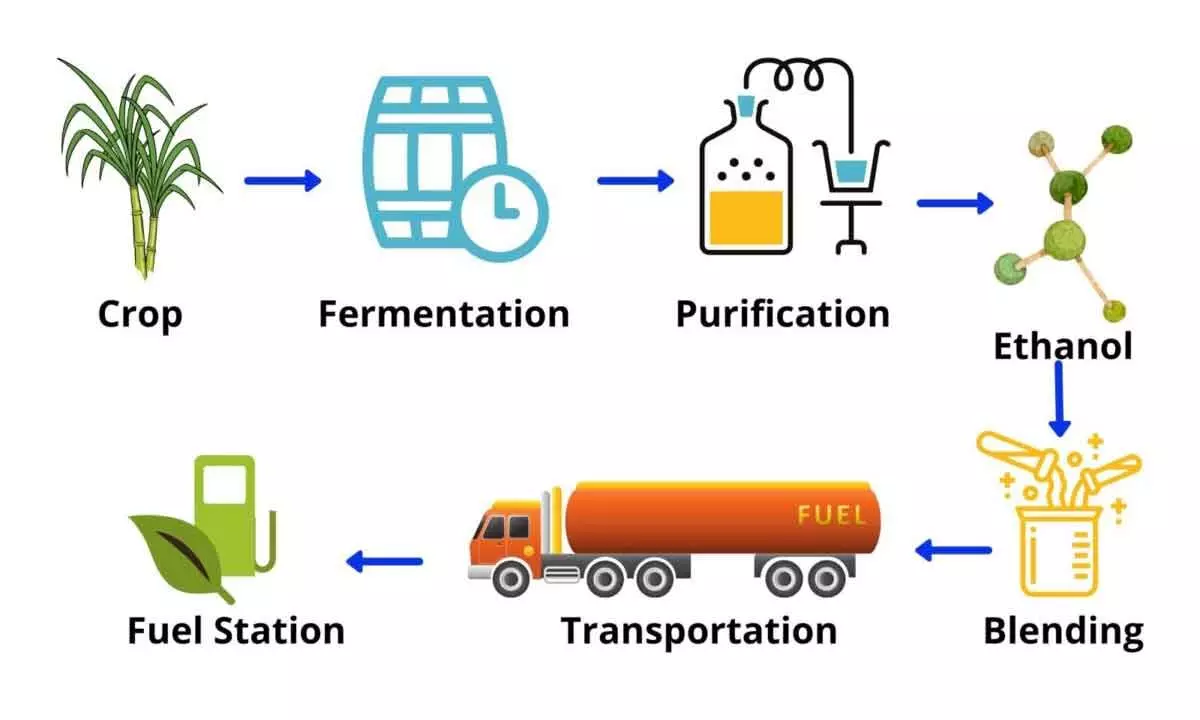Rethinking grain-based ethanol blending requires a holistic approach

Dr. M.Suresh Babu, President, Praja Science Vedika.
India's ambitious target of achieving 20% ethanol blending in fuel by 2025, particularly regarding feedstock availability and the use of food grains for ethanol production. India has introduced a 20% ethanol-blended petrol and aims to achieve nationwide coverage of ethanol-blended petrol by the year 2025. This commitment reflects the government's emphasis on reducing carbon emissions, promoting renewable energy sources, and enhancing energy security.
The move towards increasing ethanol blending in petrol is part of India's broader strategy to reduce the carbon footprint of transportation fuels, enhance energy security by reducing dependency on fossil fuel imports, and promote sustainable agricultural practices. By diversifying raw materials and expanding ethanol blending, India aims to make its transportation sector more environmentally friendly and resilient to global energy market fluctuations.
Grain-based ethanol blending in India, as in many other countries, is often used as a means to reduce the carbon footprint of gasoline and achieve certain environmental and energy security goals. Ethanol is typically blended with gasoline to create a fuel blend that contains a certain percentage of ethanol, which is usually derived from crops such as corn, sugarcane, or grains.
The Indian government is facing challenges in securing an adequate supply of feedstock, especially food grains, for ethanol production to meet the blending target. This shortage is becoming more apparent after supplying a significant quantity of rice to ethanol producers.
The Food Corporation of India (FCI) plays a vital role in supplying rice for ethanol production. However, to conserve rice stocks, FCI has temporarily halted fresh supplies from July, despite having a surplus stock compared to buffer norms. This action raises concerns about maintaining sufficient buffer stock for food security programs.
The uncertain monsoon patterns and potential impact on paddy output raise doubts about the availability of rice stocks and FCI's ability to replenish its buffer reserves. The government is considering the possibility of using maize as an alternative feedstock for ethanol production. Exploring different feedstocks could help mitigate the strain on food grains.
The text suggests that a comprehensive reevaluation of the grain-based ethanol blending program is necessary. This likely stems from concerns about the competition between food and fuel production and the potential impact on food security. The challenges discussed in the text underscore the complex interplay between energy security, environmental goals, and food security. Balancing these objectives requires careful consideration of feedstock availability, agricultural practices, and the potential consequences of diverting food grains to fuel production. A holistic approach is needed to ensure that ethanol blending goals align with broader socioeconomic and environmental objectives while safeguarding food security.
India’s grain based ethanol blending delves into the complexities and challenges, specifically focusing on the calculations, feedstock availability, economic implications, and ethical considerations. The idea of grain-based ethanol blending was proposed in a NITI Aayog expert committee report in 2021, aiming to achieve a 20% petrol blending target. The calculated requirement for ethanol was 1,016 crore litres, which led to the exploration of alternatives to meet this demand. While the sugar industry's ethanol production capacity was projected to be 684 crore litres, the report suggested alternatives like damaged foodgrains, crop residue, maize, and surplus rice from FCI. However, the availability of these feedstocks, especially damaged grains, may be limited. The report projected using surplus rice stocks from FCI to meet ethanol demand, but potential contingencies such as poor monsoons affecting FCI purchases or higher supplies to welfare schemes were not fully considered.
The government's policy of providing subsidies to private distilleries for rice-based ethanol production raises economic concerns. FCI incurs losses by supplying rice at a discounted price for ethanol production, and oil marketing companies are involved in lifting this ethanol at a mandated price. Given the challenges related to malnutrition and poverty, there are ethical concerns about diverting food grains for fuel production, especially when alternative feedstocks and methods are available. The focus should shift towards ramping up second-generation (2G) ethanol production, which involves using food waste and crop residue.
This approach could be more sustainable and less likely to compete with food resources. In light of unpredictable weather patterns affecting global food supplies, the text argues for prioritizing food security over green fuel targets. It suggests that if feedstock availability is limited, ethanol blending targets should be reconsidered and potentially lowered. The importance of a balanced approach that considers the broader societal, economic, and ethical implications of grain-based ethanol blending is the need of the hour. It emphasizes the need to explore sustainable alternatives, such as 2G ethanol production, while ensuring that food security remains a top priority, particularly in a world marked by changing climate patterns and potential food supply disruptions.
India's ethanol production program has undergone significant developments in the past five years, both in terms of the quantities supplied by sugar mills/distilleries to oil marketing companies (OMCs) and the diversification of raw materials used for ethanol production. Ethanol is a high-purity alcohol that can be blended with gasoline, providing environmental and energy security benefits.
Over the years, India's ethanol production program has evolved beyond using traditional sources like cane molasses and juice. It has embraced a broader range of raw materials such as rice, damaged grains, maize, and potentially even millets. This diversification of feedstocks helps to mitigate concerns related to using food crops for fuel production and promotes better resource utilization.
Ethanol used for blending with petrol is highly pure, typically reaching a purity level of 99.9%. This high level of purity ensures effective blending with gasoline, improving the overall quality of the fuel while reducing emissions.
The text highlights the distinction between ethanol and other types of alcohol, such as rectified spirit (used in various industries) and extra neutral alcohol (used in alcoholic beverages). This distinction is important in understanding the specific applications and benefits of each type of alcohol.




















